Post-Colonization Interval Estimates Using Multi-Species Calliphoridae Larval Masses and Spatially Distinct Temperature Data Sets: A Case Study
Abstract
:1. Introduction
2. Materials and Methods
2.1. Study Site
2.2. Temperature
2.3. Larval Collections and Measurements
2.4. ADH Ranges and Post-Colonization Intervals
2.5. Statistical Analysis
3. Results
3.1. Temperature
3.2. Calliphoridae Larvae
3.3. ADH Ranges
3.4. Post-Colonization Intervals
4. Discussion
5. Conclusions
Supplementary Materials
Acknowledgments
Author Contributions
Conflicts of Interest
References
- Byrd, J.H.; Castner, J.L. Forensic Entomology: The Utility of Arthropods in Legal Investigations; CRC Press: Boca Raton, FL, USA, 2010. [Google Scholar]
- Catts, E.P.; Haskell, N.H. Entomology and Death: A Procedural Guide; Joyce’s Print Shop, Inc.: Clemson, SC, USA, 1990. [Google Scholar]
- Tomberlin, J.K.; Mohr, R.; Benbow, M.E.; Tarone, A.M.; VanLaerhoven, S. A roadmap for bridging basic and applied research in forensic entomology. Annu. Rev. Entomol. 2011, 56, 401–421. [Google Scholar] [CrossRef] [PubMed]
- Amendt, J.; Campobasso, C.P.; Gaudry, E.; Reiter, C.; LeBlanc, H.N.; Hall, M.J. Best practice in forensic entomology—Standards and guidelines. Int. J. Legal Med. 2007, 121, 90–104. [Google Scholar] [CrossRef] [PubMed]
- Anderson, G.S. Comparison of decomposition rates and faunal colonization of carrion in indoor and outdoor environments. J. Forensic Sci. 2011, 56, 136–142. [Google Scholar] [CrossRef] [PubMed]
- Goff, M.L. Problems in estimation of postmortem interval resulting from wrapping of the corpse: A case study from Hawaii. J. Agric. Entomol. 1992, 9, 237–243. [Google Scholar]
- Bugajski, K.N. An Examination of the Effect of Household Chemicals on Blow Fly Oviposition, Growth, Development, and Estimations of the Post Mortem Interval. Ph.D. Thesis, Purdue University, West Lafayette, IN, USA, 2011. [Google Scholar]
- Avila, F.W.; Goff, M.L. Arthropod succession patterns onto burnt carrion in two contrasting habitats in the Hawaiian islands. J. Forensic Sci. 1998, 43, 581–586. [Google Scholar] [CrossRef] [PubMed]
- Kreitlow, K.L. Insect Succession in a Natural Environment. In Forensic Entomology: The Utility of Arthropods in Legal Investigations; Byrd, J.H., Castner, J.L., Eds.; CRC Press: Boca Raton, FL, USA, 2010; pp. 251–269. [Google Scholar]
- Merritt, R.W.; De Jong, G.D. Arthropod Communities in Terrestrial Environments. In Carrion Ecology, Evolution, and Their Applications; Benbow, M.E., Tomberlin, J.K., Tarone, A.M., Eds.; CRC Press: Boca Raton, FL, USA, 2016; pp. 65–91. [Google Scholar]
- Davidson, J. On the relationship between temperature and rate of development of insects at constant temperatures. J. Anim. Ecol. 1944, 13, 26–38. [Google Scholar] [CrossRef]
- Richards, C.S.; Villet, M.H. Data quality in thermal summation development models for forensically important blowflies. Med. Vet. Entomol. 2009, 23, 269–276. [Google Scholar] [CrossRef] [PubMed]
- Richards, C.S.; Villet, M.H. Factors affecting accuracy and precision of thermal summation models of insect development used to estimate post-mortem intervals. Int. J. Legal Med. 2008, 122, 401–408. [Google Scholar] [CrossRef] [PubMed]
- Catts, E.P. Problems in estimating the postmortem interval in death investigations. J. Agric. Entomol. 1992, 9, 245–255. [Google Scholar]
- Mahat, N.A.; Zafarina, Z.; Jayaprakash, P.T. Influence of rain and malathion on the oviposition and development of blowflies (Diptera: Calliphoridae) infesting rabbit carcasses in Kelantan, Malaysia. Forensic Sci. Int. 2009, 192, 19–28. [Google Scholar] [CrossRef] [PubMed]
- Goff, M.L.; Brown, W.A.; Omori, A.I. Preliminary observations of the effect of methamphetamine in decomposing tissues on the development rate of Parasarcophaga ruficornis (Diptera: Sarcophagidae) and implications of this effect on the estimations of postmortem intervals. J. Forensic Sci. 1992, 37, 867–872. [Google Scholar] [PubMed]
- Goff, M.L.; Brown, W.A.; Hewadikaram, K.A.; Omori, A.I. Effect of heroin in decomposing tissues on the development rate of Boettcherisca peregrina (Diptera, Sarcophagidae) and implications of this effect on estimation of postmortem intervals using arthropod development patterns. J. Forensic Sci. 1991, 36, 537–542. [Google Scholar] [CrossRef] [PubMed]
- Goff, M.L.; Omori, A.I.; Goodbrod, J.R. Effect of cocaine in tissues on the development rate of Boettcherisca peregrina (Diptera: Sarcophagidae). J. Med. Entomol. 1989, 26, 91–93. [Google Scholar] [CrossRef] [PubMed]
- Greenberg, B. Flies as forensic indicators. J. Med. Entomol. 1991, 28, 565–577. [Google Scholar] [CrossRef] [PubMed]
- Picard, C.J.; Deblois, K.; Tovar, F.; Bradley, J.L.; Johnston, J.S.; Tarone, A.M. Increasing Precision in development-based postmortem interval estimates: What‘s sex got to do with it? J. Med. Entomol. 2013, 50, 425–431. [Google Scholar] [CrossRef] [PubMed]
- Owings, C.G.; Spiegelman, C.; Tarone, A.M.; Tomberlin, J.K. Developmental variation among Cochliomyia macellaria Fabricius (Diptera: Calliphoridae) populations from three ecoregions of Texas, USA. Int. J. Legal Med. 2014, 128, 709–717. [Google Scholar] [CrossRef] [PubMed]
- Tarone, A.M.; Foran, D.R. Components of developmental plasticity in a Michigan population of Lucilia sericata (Diptera: Calliphoridae). J. Med. Entomol. 2006, 43, 1023–1033. [Google Scholar] [CrossRef] [PubMed]
- Clark, K.; Evans, L.; Wall, R. Growth rates of the blowfly, Lucilia sericata, on different body tissues. Forensic Sci. Int. 2006, 156, 145–149. [Google Scholar] [CrossRef] [PubMed]
- Ahmad, A.; Broce, A.; Zurek, L. Evaluation of significance of bacteria in larval development of Cochliomyia macellaria (Diptera: Calliphoridae). J. Med. Entomol. 2006, 43, 1129–1133. [Google Scholar] [CrossRef] [PubMed]
- Daubert v. Merrell Dow Pharmaceuticals, Inc. 1993. Available online: https://supreme.justia.com/cases/federal/us/509/579/case.html (accessed on 5 September 2015).
- National Research Council. Strengthening Forensic Science in the United States: A Path Forward. In Committee on the Judiciary House of Representatives; U.S. Government Printing Office: Washington, DC, USA, 2009. [Google Scholar]
- Tomberlin, J.K.; Benbow, M.E.; Tarone, A.M.; Mohr, R.M. Basic research in evolution and ecology enhances forensics. Trends Ecol. Evol. 2011, 26, 53–55. [Google Scholar] [CrossRef] [PubMed]
- Tomberlin, J.K.; Benbow, M.E. Forensic Entomology: International Dimensions and Frontiers; CRC Press: Boca Raton, FL, USA, 2015. [Google Scholar]
- Gruner, S.V.; Slone, D.H.; Capinera, J.L. Forensically important Calliphoridae (Diptera) associated with pig carrion in rural North-Central Florida. J. Med. Entomol. 2007, 44, 509–515. [Google Scholar] [CrossRef] [PubMed]
- Byrd, J.H.; Butler, J.F. Effects of temperature on Cochliomyia macellaria (Diptera: Calliphoridae) development. J. Med. Entomol. 1996, 33, 901–905. [Google Scholar] [CrossRef] [PubMed]
- Byrd, J.H.; Allen, J.C. The development of the black blow fly, Phormia regina (Meigen). Forensic Sci. Int. 2001, 120, 79–88. [Google Scholar] [CrossRef]
- Baker, D.G. Climate of Minnesota. Part XV, Normal Temperatures (1951–80) and Their Application. Available online: https://www.google.com.hk/url?sa=t&rct=j&q=&esrc=s&source=web&cd=2&ved=0ahUKEwj7ksOY0P3SAhXIzbwKHb7gAOQQFggfMAE&url=https%3A%2F%2Fconservancy.umn.edu%2Fbitstream%2Fhandle%2F11299%2F122927%2FSB566.pdf%3Fsequence%3D1%26isAllowed%3Dy&usg=AFQjCNHyq4xq1fhfX6iV0WxN7rDvuk1FhA (accessed on 5 September 2014).
- Baque, M.; Amendt, J. Strengthen forensic entomology in court—The need for data exploration and the validation of a generalised additive mixed model. Int. J. Legal Med. 2013, 127, 213–223. [Google Scholar] [CrossRef] [PubMed]
- Lamotte, L.R.; Wells, J.D. Inverse prediction for multivariate mixed models with standard software. Stat. Papers 2016, 57, 929–938. [Google Scholar] [CrossRef]
- Ieno, E.N.; Amendt, J.; Fremdt, H.; Saveliev, A.A.; Zuur, A.F. Analysing Forensic Entomology Data Using Additive Mixed Effects Modeling. In Current Concepts in Forensic Entomology; Amendt, J., Goff, M.L., Campobasso, C.P., Grassberger, M., Eds.; Springer: Dordrecht, The Netherlands, 2010; pp. 139–162. [Google Scholar]
- Catts, E.P.; Goff, M.L. Forensic entomology in criminal investigations. Annu. Rev. Entomol. 1992, 37, 253–272. [Google Scholar] [CrossRef] [PubMed]
- Pechal, J.L.; Crippen, T.L.; Tarone, A.M.; Lewis, A.J.; Tomberlin, J.K.; Benbow, M.E. Microbial community functional change during vertebrate carrion decomposition. PLoS ONE 2013, 8, e79035. [Google Scholar] [CrossRef] [PubMed]
- Pechal, J.L.; Benbow, M.E.; Crippen, T.L.; Tarone, A.M.; Tomberlin, J.K. Delayed insect access alters carrion decomposition and necrophagous insect community assembly. Ecosphere 2014, 5, 1–21. [Google Scholar] [CrossRef]
- Pechal, J.L.; Crippen, T.L.; Benbow, M.E.; Tarone, A.M.; Dowd, S.; Tomberlin, J.K. The potential use of bacterial community succession in forensics as described by high-throughput metagenomic sequencing. Int. J. Legal Med. 2013, 128, 193–205. [Google Scholar] [CrossRef] [PubMed]
- Benbow, M.E.; Lewis, A.J.; Tomberlin, J.K.; Pechal, J.L. Seasonal necrophagous insect community assembly during vertebrate carrion decomposition. J. Med. Entomol. 2013, 50, 440–450. [Google Scholar] [CrossRef] [PubMed]
- Gennard, D. Forensic Entomology: An Introduction; John Wiley & Sons, Ltd.: Chichester, UK, 2012. [Google Scholar]
- Smith, K.G.V. A Manual of Forensic Entomology; Cornell University Press: Ithaca, NY, USA, 1986. [Google Scholar]
- Stojanovich, C.J.; Pratt, H.D.; Bennington, E.E. Fly Larvae: Key to Some Species of Public Health Importance; U.S. Department of Health, Education, and Welfare: Atlanta, GA, USA, 1962.
- Wells, J.D.; Byrd, J.H.; Tantawi, T.I. Key to third-instar chyrsomyinae (Diptera: Calliphoridae) from carrion in the Continental United States. J. Med. Entomol. 1999, 36, 638–641. [Google Scholar] [CrossRef] [PubMed]
- Schneider, C.A.; Rasband, W.S.; Eliceiri, K.W. NIH Image to ImageJ: 25 years of image analysis. Nat. Methods 2012, 9, 671–675. [Google Scholar] [CrossRef] [PubMed]
- Anderson, G.S.; VanLaerhoven, S.L. Forensic Entomology. In The Lawyer's Guide to the Forensic Sciences; Irwin Law: Toronto, ON, Canada, 2016. [Google Scholar]
- Roe, A.L. Development modeling of Lucilia sericata and Phormia regina (Diptera: Calliphoridae). Available online: http://digitalcommons.unl.edu/natresdiss/93/ (accessed on 16 September 2015).
- Nabity, P.D.; Higley, L.G.; Heng-moss, T.M. Effects of temperature on development of Phormia regina (Diptera: Calliphoridae) and use of developmental data in determining time intervals in forensic entomology. J. Med. Entomol. 2006, 43, 1276–1286. [Google Scholar] [CrossRef] [PubMed]
- Anderson, G.S. Minimum and maximum development rates of some forensically important Calliphoridae (Diptera). J. Forensic Sci. 2000, 45, 824–832. [Google Scholar] [CrossRef] [PubMed]
- Boatright, S.A.; Tomberlin, J.K. Effects of temperature and tissue type on the development of Cochliomyia macellaria (Diptera: Calliphoridae). J. Med. Entomol. 2010, 47, 917–923. [Google Scholar] [CrossRef] [PubMed]
- Monthei, D.R. Entomotoxicological and Thermal Factors Affecting the Development of Forensically Important Flies. Ph.D. Thesis, Virginia Polytechnic Institute and State University, Blacksburg, VA, USA, 2009. [Google Scholar]
- Núñez-Vázquez, C.; Tomberlin, J.K.; Cantú-Sifuentes, M.; García-Martínez, O. Laboratory development and field validation of Phormia regina (Diptera: Calliphoridae). J. Med. Entomol. 2013, 50, 252–260. [Google Scholar] [CrossRef] [PubMed]
- Wilson, J.M.; Lafon, N.W.; Kreitlow, K.L.; Brewster, C.C.; Fell, R.D. Comparing growth of pork- and venison-reared Phormia regina (Diptera: Calliphoridae) for the application of forensic entomology to wildlife poaching. J. Med. Entomol. 2014, 51, 1067–1072. [Google Scholar] [CrossRef] [PubMed]
- VanLaerhoven, S.L. Blind validation of postmortem interval estimates using developmental rates of blow flies. Forensic Sci. Int. 2008, 180, 76–80. [Google Scholar] [CrossRef] [PubMed]
- Wells, J.D.; Lamotte, L.R. Estimating the Postmortem Interval. In Forensic Entomology: The Utility of Arthropods in legal Investigations; Byrd, J.H., Castner, J.L., Eds.; CRC Press: Boca Raton, FL, USA, 2010; pp. 367–388. [Google Scholar]
- Box, G.E.P. Some theorems on quadratic forms applied in the study of analysis of variance problems, II. effects of inequality of variance and of correlation between errors in the two-way classification. Ann. Math. Stat. 1954, 25, 484–498. [Google Scholar] [CrossRef]
- SAS Institute, Inc. SAS Studio 3.5: User's Guide; SAS Institute Inc.: Cary, NC, USA, 2016. [Google Scholar]
- Weatherbee, C.R.; Pechal, J.L.; Eric Benbow, M. The dynamic maggot mass microbiome. Ann. Entomol. Soc. Am. 2017, 110, 45–53. [Google Scholar] [CrossRef]
- Archer, M.S. The effect of time after body discovery on the accuracy of retrospective weather station ambient temperature corrections in forensic entomology. J. Forensic Sci. 2004, 49. [Google Scholar] [CrossRef]
- Higley, L.G.; Pedigo, L.P.; Ostlie, K.R. Degday: A program for calculating degree-days, and assumptions behind the degree-day approach. Environ. Entomol. 1986, 15, 999–1016. [Google Scholar] [CrossRef]
- Rosati, J.Y. Spatial and Temporal Variability in the Carrion Insect Community: Using Blow Flies (Family: Calliphoridae) as a Model System to Study Coexistence Mechanisms at Multiple Scales. Ph.D. Thesis, University of Windsor, Windsor, ON, Canada, 2014. [Google Scholar]
- Tantawi, T.I.; Greenberg, B. The effect of killing and preservative solutions on estimates of maggot age in forensic cases. J. Forensic Sci. 1993, 38, 702–707. [Google Scholar] [CrossRef] [PubMed]
- Bugajski, K.N.; Seddon, C.C.; Williams, R.E. A comparison of blow fly (Diptera: Calliphoridae) and Beetle (Coleoptera) activity on refrigerated only versus frozen-thawed pig carcasses in Indiana. J. Med. Entomol. 2011, 48, 1231–1235. [Google Scholar] [CrossRef] [PubMed]
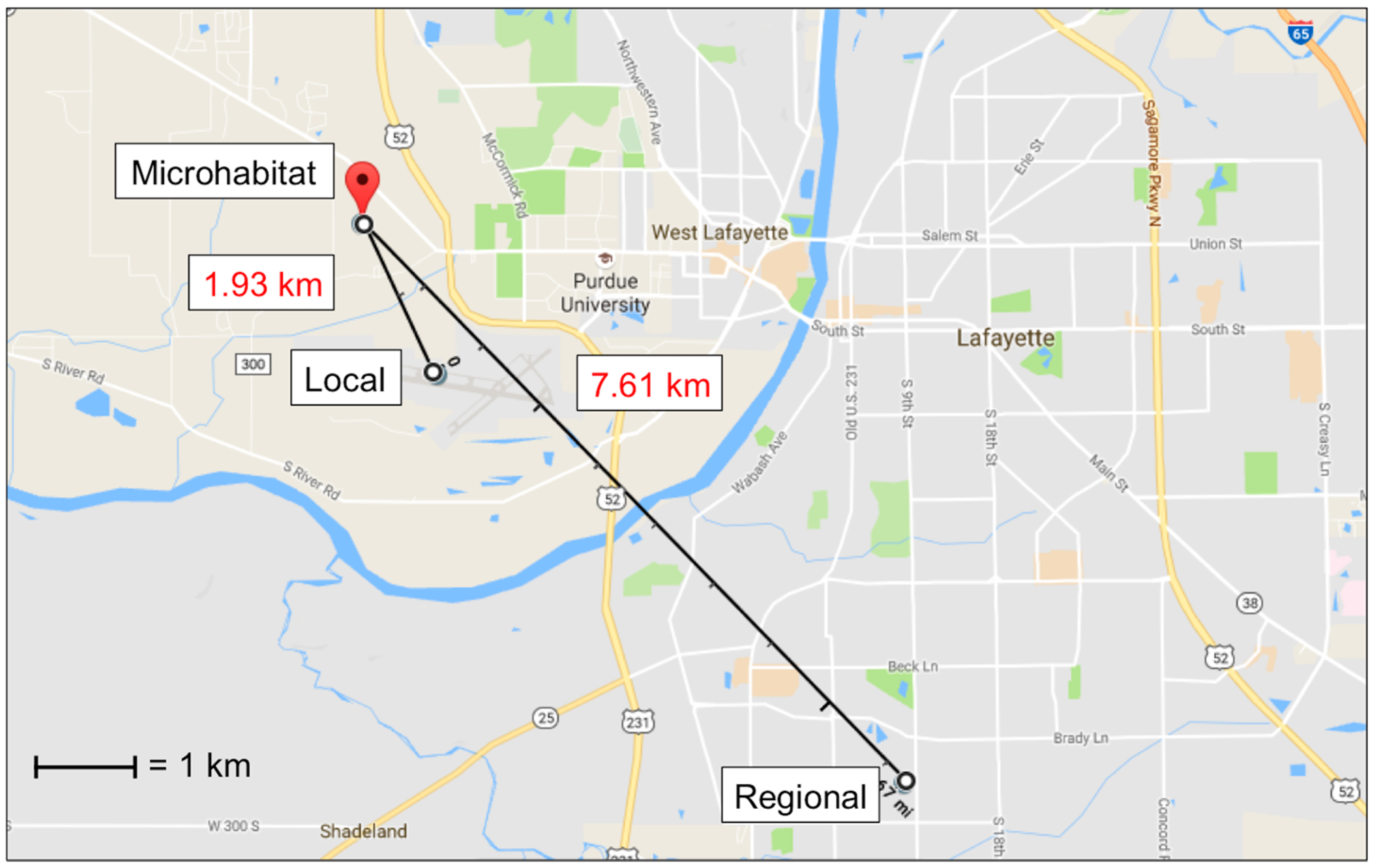

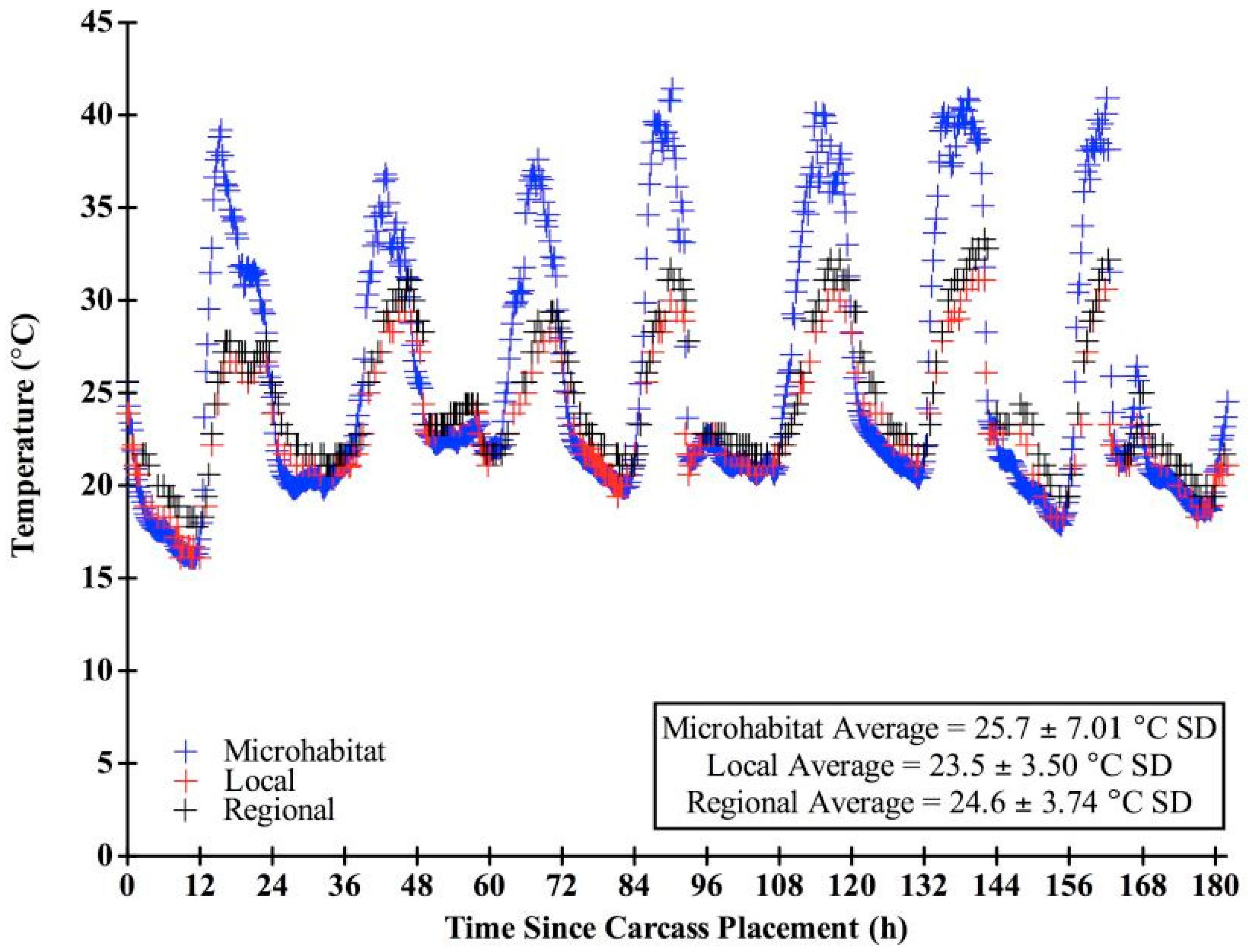
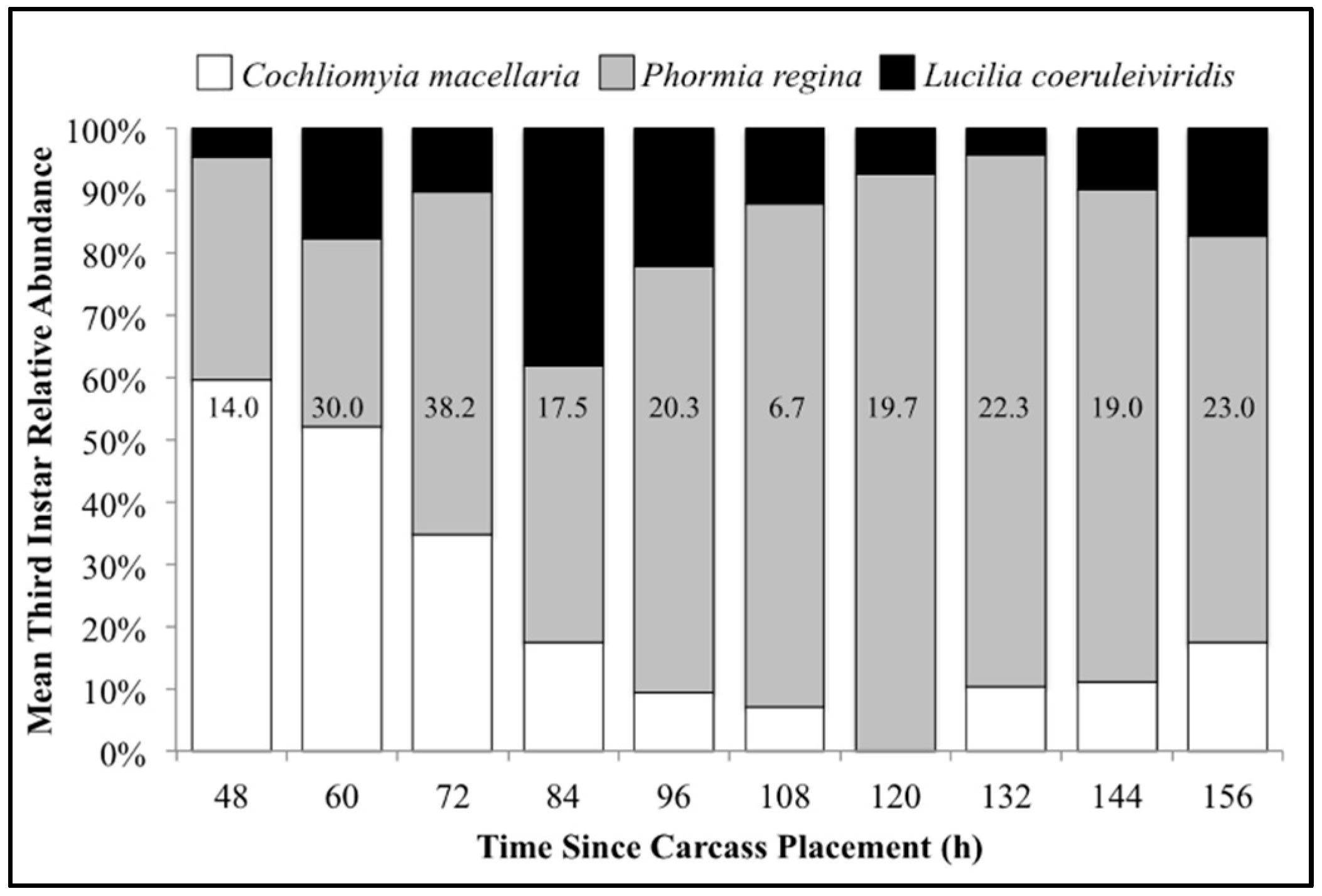

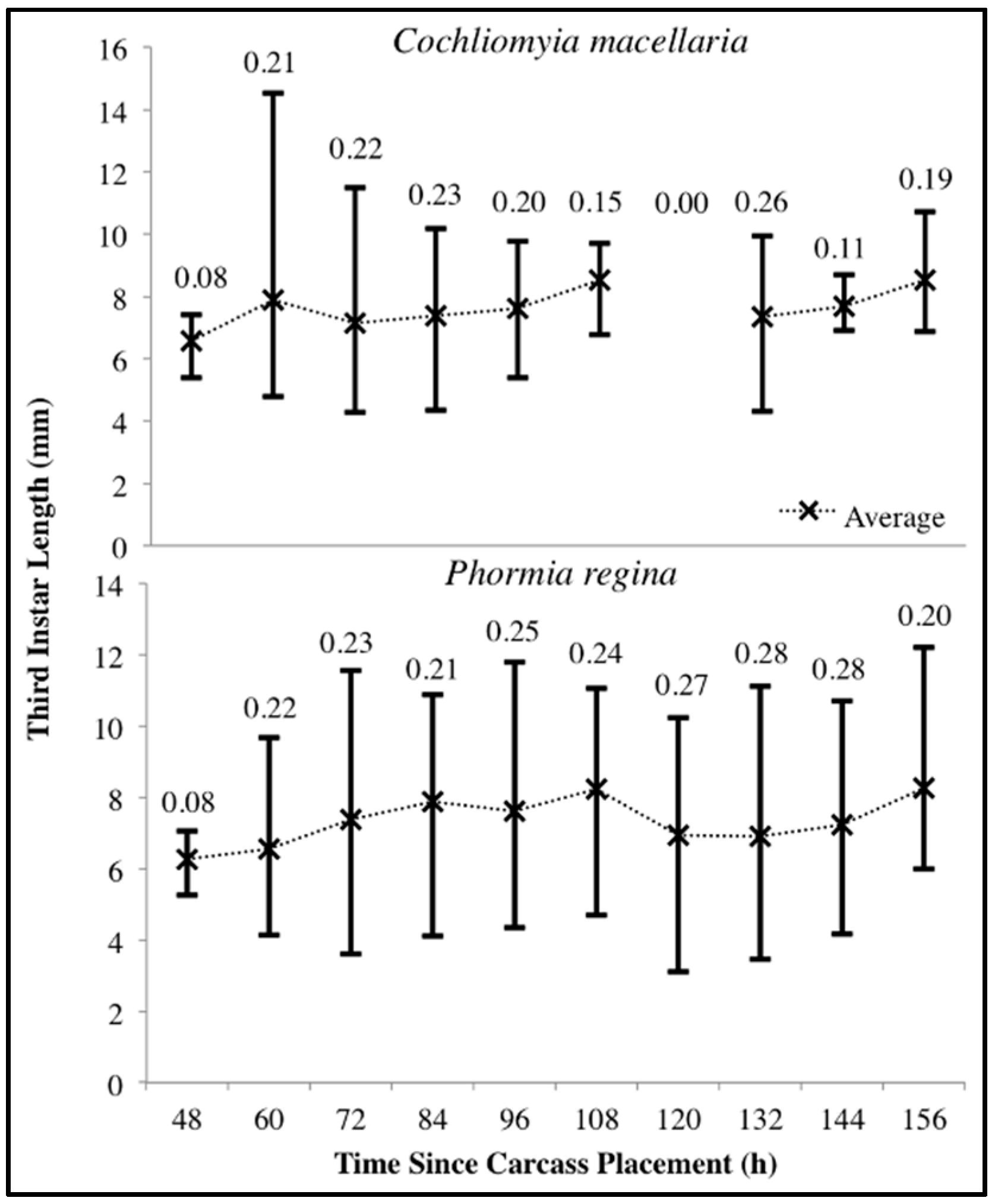
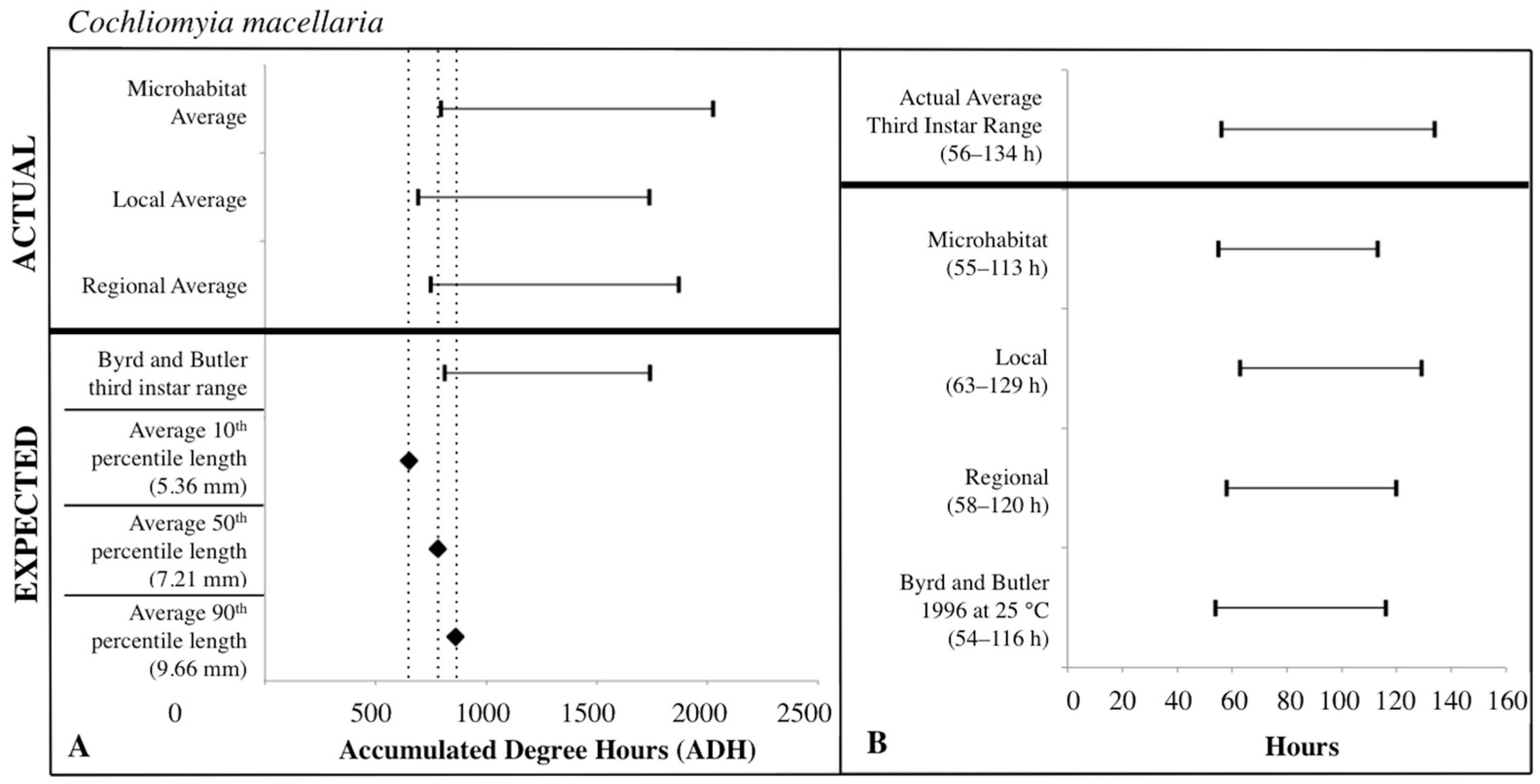
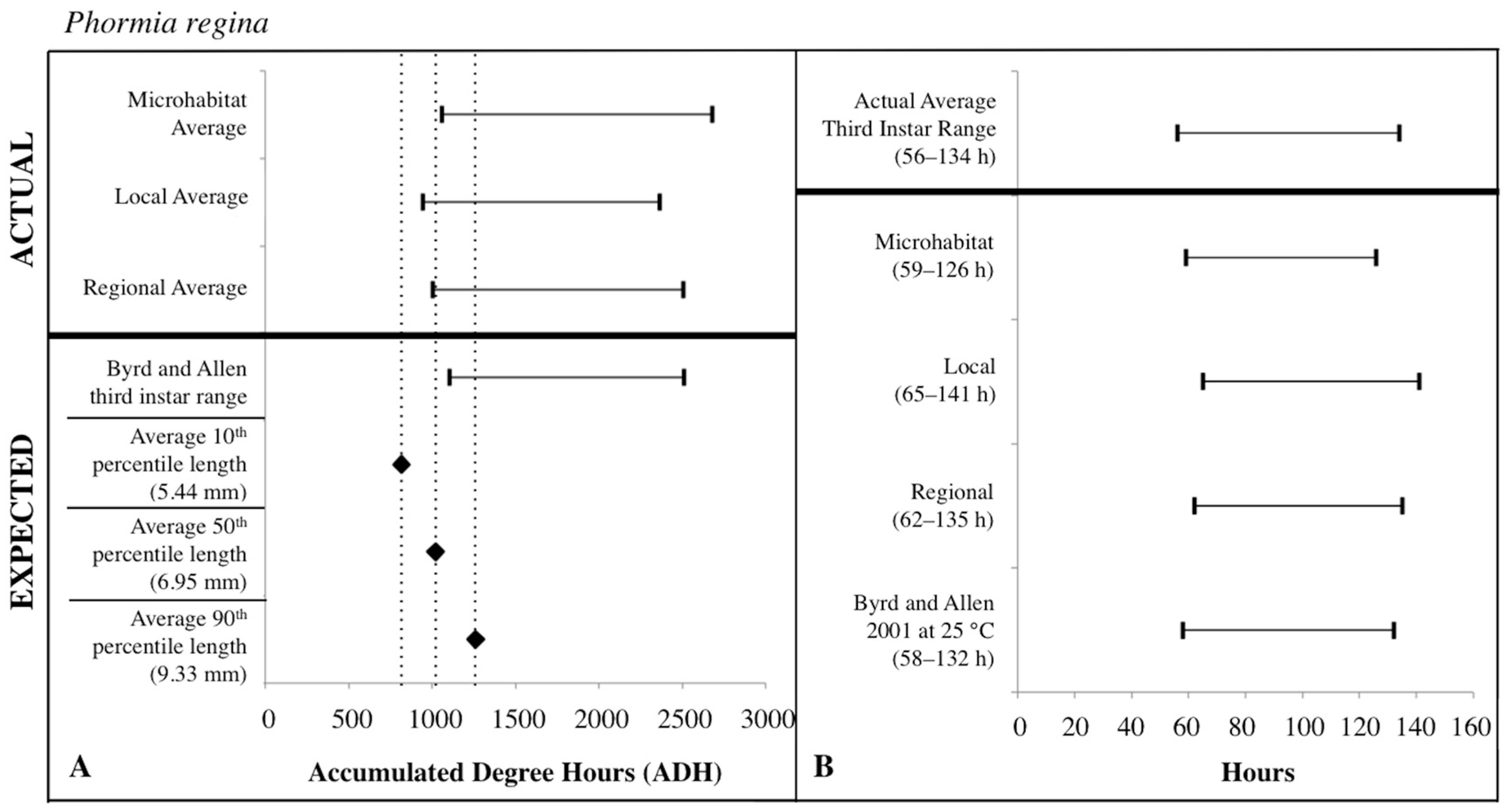
| Third Instar Range (h) | 10th Percentile | 50th Percentile | 90th Percentile | ||||||||||||||||||
| Byrd and Butler 1996 | Individual | Microhabitat | Local | Regional | Length (mm) | Length (mm) | Length (mm) | ||||||||||||||
| Carcass | Min | Med | Max | Min | Med | Max | Min | Med | Max | Min | Med | Max | Min | Med | Max | ADH | ADH | ADH | |||
| 1 | 810 | 1275 | 1740 | 727 | 1575 | 2423 | 718 | 1603 | 2487 | 610 | 1371 | 2132 | 663 | 1482 | 2300 | 5.70 | 690 | 7.40 | 780 | 10.08 | 870 |
| 2 | 810 | 1275 | 1740 | 706 | 1108 | 1510 | 718 | 1112 | 1506 | 610 | 946 | 1282 | 663 | 1025 | 1386 | 5.83 | 690 | 7.11 | 780 | 9.23 | 840 |
| 3 | 810 | 1275 | 1740 | 743 | 1247 | 1750 | 718 | 1180 | 1641 | 610 | 1016 | 1422 | 663 | 1098 | 1532 | 5.31 | 630 | 7.16 | 780 | 9.56 | 855 |
| 4 | 810 | 1275 | 1740 | 916 | 1523 | 2129 | 871 | 1471 | 2071 | 770 | 1279 | 1787 | 830 | 1376 | 1922 | 5.37 | 630 | 8.34 | 810 | 10.22 | 885 |
| 5 | 810 | 1275 | 1740 | 846 | 1560 | 2274 | 871 | 1621 | 2370 | 770 | 1387 | 2003 | 830 | 1494 | 2157 | 5.02 | 630 | 7.21 | 780 | 9.66 | 870 |
| 6 | 810 | 1275 | 1740 | 831 | 1411 | 1990 | 871 | 1471 | 2071 | 770 | 1279 | 1787 | 830 | 1376 | 1922 | 4.94 | 630 | 6.03 | 750 | 9.24 | 840 |
| Mean | 810 | 1275 | 1740 | 795 | 1404 | 2013 | 795 | 1410 | 2024 | 690 | 1213 | 1736 | 747 | 1309 | 1870 | 5.36 | 650 | 7.21 | 780 | 9.66 | 860 |
| CV | 0.10 | 0.14 | 0.17 | 0.11 | 0.15 | 0.19 | 0.13 | 0.15 | 0.19 | 0.12 | 0.15 | 0.19 | 0.07 | 0.05 | 0.10 | 0.02 | 0.04 | 0.02 | |||
| Third Instar Range (h) | 10th Percentile | 50th Percentile | 90th Percentile | ||||||||||||||||||
| Byrd and Allen 2001 | Individual | Microhabitat | Local | Regional | Length (mm) | Length (mm) | Length (mm) | ||||||||||||||
| Carcass | Min | Med | Max | Min | Med | Max | Min | Med | Max | Min | Med | Max | Min | Med | Max | ADH | ADH | ADH | |||
| 1 | 1102 | 1805 | 2508 | 898 | 1973 | 3047 | 910 | 2011 | 3111 | 802 | 1779 | 2756 | 855 | 1890 | 2924 | 6.00 | 855 | 8.32 | 1216 | 10.34 | 1311 |
| 2 | 1102 | 1805 | 2508 | 919 | 1657 | 2395 | 910 | 1659 | 2408 | 802 | 1456 | 2109 | 855 | 1544 | 2233 | 5.28 | 836 | 6.60 | 874 | 9.61 | 1273 |
| 3 | 1102 | 1805 | 2508 | 935 | 1749 | 2563 | 910 | 1659 | 2408 | 802 | 1456 | 2109 | 855 | 1544 | 2233 | 4.94 | 836 | 6.77 | 1007 | 9.03 | 1254 |
| 4 | 1102 | 1805 | 2508 | 1156 | 1907 | 2657 | 1111 | 1855 | 2599 | 1010 | 1663 | 2315 | 1070 | 1760 | 2450 | 5.97 | 855 | 8.05 | 1197 | 9.97 | 1292 |
| 5 | 1102 | 1805 | 2508 | 1086 | 1968 | 2850 | 1111 | 2029 | 2946 | 1010 | 1795 | 2579 | 1070 | 1902 | 2733 | 6.50 | 874 | 6.90 | 988 | 9.28 | 1254 |
| 6 | 1102 | 1805 | 2508 | 1365 | 1942 | 2518 | 1406 | 2003 | 2599 | 1241 | 1778 | 2315 | 1311 | 1881 | 2450 | 3.93 | 646 | 5.04 | 836 | 7.76 | 1178 |
| Mean | 1102 | 1805 | 2508 | 1060 | 1866 | 2672 | 1060 | 1869 | 2679 | 945 | 1655 | 2364 | 1003 | 1754 | 2504 | 5.44 | 817 | 6.95 | 1020 | 9.33 | 1260 |
| CV | 0.17 | 0.07 | 0.09 | 0.19 | 0.09 | 0.11 | 0.19 | 0.10 | 0.11 | 0.18 | 0.10 | 0.11 | 0.17 | 0.10 | 0.17 | 0.16 | 0.10 | 0.04 | |||
| Third Instar Range (h) | ||||||||||||||||||
|---|---|---|---|---|---|---|---|---|---|---|---|---|---|---|---|---|---|---|
| Actual | Byrd and Butler 1996 | Individual | Microhabitat | Local | Regional | |||||||||||||
| Carcass | Min | Med | Max | Min | Med | Max | Min | Med | Max | Min | Med | Max | Min | Med | Max | Min | Med | Max |
| 1 | 48 | 102 | 156 | 54 | 85 | 116 | 56 | 86 | 115 | 55 | 84 | 113 | 63 | 96 | 129 | 58 | 89 | 120 |
| 2 | 48 | 72 | 96 | 54 | 85 | 116 | 54 | 84 | 113 | 55 | 84 | 113 | 63 | 96 | 129 | 58 | 89 | 120 |
| 3 | 48 | 78 | 108 | 54 | 85 | 116 | 53 | 81 | 108 | 55 | 84 | 113 | 63 | 96 | 129 | 58 | 89 | 120 |
| 4 | 60 | 96 | 132 | 54 | 85 | 116 | 51 | 81 | 111 | 55 | 84 | 113 | 63 | 96 | 129 | 58 | 89 | 120 |
| 5 | 60 | 102 | 144 | 54 | 85 | 116 | 57 | 86 | 115 | 55 | 84 | 113 | 63 | 96 | 129 | 58 | 89 | 120 |
| 6 | 60 | 96 | 132 | 54 | 85 | 116 | 58 | 88 | 117 | 55 | 84 | 113 | 63 | 96 | 129 | 58 | 89 | 120 |
| Average | 56 | 91 | 134 | 54 | 85 | 116 | 55 | 84 | 113 | 55 | 84 | 113 | 63 | 96 | 129 | 58 | 89 | 120 |
| Coefficient of Variation | 0.12 | 0.14 | 0.17 | 0.05 | 0.03 | 0.03 | ||||||||||||
| Third Instar Range (h) | ||||||||||||||||||
|---|---|---|---|---|---|---|---|---|---|---|---|---|---|---|---|---|---|---|
| Actual | Byrd and Allen 2001 | Individual | Microhabitat | Local | Regional | |||||||||||||
| Carcass | Min | Med | Max | Min | Med | Max | Min | Med | Max | Min | Med | Max | Min | Med | Max | Min | Med | Max |
| 1 | 48 | 102 | 156 | 58 | 95 | 132 | 60 | 95 | 130 | 59 | 93 | 126 | 65 | 103 | 141 | 62 | 99 | 135 |
| 2 | 48 | 84 | 120 | 58 | 95 | 132 | 59 | 93 | 127 | 59 | 93 | 126 | 65 | 103 | 141 | 62 | 99 | 135 |
| 3 | 48 | 84 | 120 | 58 | 95 | 132 | 57 | 88 | 118 | 59 | 93 | 126 | 65 | 103 | 141 | 62 | 99 | 135 |
| 4 | 60 | 96 | 132 | 58 | 95 | 132 | 56 | 90 | 123 | 59 | 93 | 126 | 65 | 103 | 141 | 62 | 99 | 135 |
| 5 | 60 | 102 | 144 | 58 | 95 | 132 | 61 | 96 | 131 | 59 | 93 | 126 | 65 | 103 | 141 | 62 | 99 | 135 |
| 6 | 72 | 102 | 132 | 58 | 95 | 132 | 61 | 97 | 132 | 59 | 93 | 126 | 65 | 103 | 141 | 62 | 99 | 135 |
| Average | 56 | 95 | 134 | 58 | 95 | 132 | 59 | 93 | 127 | 59 | 93 | 126 | 65 | 103 | 141 | 62 | 99 | 135 |
| Coefficient of Variation | 0.18 | 0.09 | 0.11 | 0.04 | 0.04 | 0.04 | ||||||||||||
| Actual | 10th Percentile | 50th Percentile | 90th Percentile | ||||||||||||||||
|---|---|---|---|---|---|---|---|---|---|---|---|---|---|---|---|---|---|---|---|
| Carcass | Third Instar Range | Length (mm) | Byrd | Individual | Microhabitat | Local | Regional | Length (mm) | Byrd | Individual | Microhabitat | Local | Regional | Length (mm) | Byrd | Individual | Microhabitat | Local | Regional |
| 1 | 48–156 | 5.70 | 46 | 46–47 | 46–47 | 54 | 49–50 | 7.40 | 52 | 53–54 | 52–53 | 60–61 | 56–57 | 10.08 | 58 | 61 | 59–60 | 67–68 | 63–64 |
| 2 | 48–96 | 5.83 | 46 | 45–46 | 46–47 | 54 | 49–50 | 7.11 | 52 | 53–54 | 52–53 | 60–61 | 56–57 | 9.23 | 56 | 57 | 57–58 | 65–66 | 60–61 |
| 3 | 48–108 | 5.31 | 42 | 42–43 | 43–44 | 49–50 | 46–47 | 7.16 | 52 | 53–54 | 52–53 | 60–61 | 56–57 | 9.56 | 57 | 56–57 | 58–59 | 66–67 | 62–63 |
| 4 | 60–132 | 5.37 | 42 | 41–42 | 43–44 | 49–50 | 46–47 | 8.34 | 54 | 56–57 | 55–56 | 63–64 | 58–59 | 10.22 | 59 | 57–58 | 61–62 | 68–69 | 64–65 |
| 5 | 60–144 | 5.02 | 42 | 44–45 | 43–44 | 49–50 | 46–47 | 7.21 | 52 | 53–54 | 52–53 | 60–61 | 56–57 | 9.66 | 58 | 61–62 | 59–60 | 67–68 | 63–64 |
| 6 | 60–132 | 4.94 | 42 | 45–46 | 43–44 | 49–50 | 46–47 | 6.03 | 50 | 51–52 | 50–51 | 58–59 | 54–55 | 9.24 | 56 | 60–61 | 57–58 | 65–66 | 60–61 |
| Average | 56–134 | 5.36 | 43 | 44–45 | 44–45 | 51 | 47–48 | 7.21 | 52 | 53–54 | 52–53 | 60–61 | 56–57 | 9.66 | 57 | 59 | 59 | 66–67 | 62–63 |
| Coefficient of Variation | 0.07 | 0.05 | 0.10 | 0.02 | 0.04 | 0.02 | |||||||||||||
| Actual | 10th Percentile | 50th Percentile | 90th Percentile | ||||||||||||||||
|---|---|---|---|---|---|---|---|---|---|---|---|---|---|---|---|---|---|---|---|
| Carcass | Third Instar Range | Length (mm) | Byrd | Individual | Microhabitat | Local | Regional | Length (mm) | Byrd | Individual | Microhabitat | Local | Regional | Length (mm) | Byrd | Individual | Microhabitat | Local | Regional |
| 1 | 48–156 | 6.00 | 45 | 45–46 | 45–46 | 51–52 | 48 | 8.32 | 64 | 65–66 | 65–66 | 70–71 | 67–68 | 10.34 | 69 | 69–70 | 68–69 | 76–77 | 72 |
| 2 | 48–120 | 5.28 | 44 | 44–45 | 44–45 | 49–50 | 47–48 | 6.60 | 46 | 45–46 | 46–47 | 52–53 | 48–49 | 9.61 | 67 | 66–67 | 67–68 | 73–74 | 70–71 |
| 3 | 48–120 | 4.94 | 44 | 43–44 | 44–45 | 49–50 | 47–48 | 6.77 | 53 | 52–53 | 53–54 | 59–60 | 56–57 | 9.03 | 66 | 65–66 | 66–67 | 72–73 | 69–70 |
| 4 | 60–132 | 5.97 | 45 | 43–44 | 45–46 | 51–52 | 48 | 8.05 | 63 | 62–63 | 64–65 | 69–70 | 67 | 9.97 | 68 | 66 | 67–68 | 74–75 | 71–72 |
| 5 | 60–144 | 6.50 | 46 | 47–48 | 46–47 | 52–53 | 48–49 | 6.90 | 52 | 54–55 | 52–53 | 58–59 | 55–56 | 9.28 | 66 | 67–68 | 66–67 | 72–73 | 69–70 |
| 6 | 72–132 | 3.93 | 34 | 39–40 | 37–38 | 41–42 | 38–39 | 5.04 | 44 | 46–47 | 44–45 | 49–50 | 47–48 | 7.76 | 62 | 65–66 | 63–64 | 69–70 | 66–67 |
| Average | 56–134 | 5.44 | 43 | 44 | 44 | 49–50 | 46–47 | 6.95 | 54 | 54–55 | 54–55 | 60 | 57–58 | 9.33 | 66 | 66–67 | 66–67 | 73–74 | 69–70 |
| Coefficient of Variation | 0.17 | 0.10 | 0.17 | 0.16 | 0.10 | 0.04 | |||||||||||||
© 2017 by the authors. Licensee MDPI, Basel, Switzerland. This article is an open access article distributed under the terms and conditions of the Creative Commons Attribution (CC BY) license (http://creativecommons.org/licenses/by/4.0/).
Share and Cite
Weatherbee, C.R.; Pechal, J.L.; Stamper, T.; Benbow, M.E. Post-Colonization Interval Estimates Using Multi-Species Calliphoridae Larval Masses and Spatially Distinct Temperature Data Sets: A Case Study. Insects 2017, 8, 40. https://doi.org/10.3390/insects8020040
Weatherbee CR, Pechal JL, Stamper T, Benbow ME. Post-Colonization Interval Estimates Using Multi-Species Calliphoridae Larval Masses and Spatially Distinct Temperature Data Sets: A Case Study. Insects. 2017; 8(2):40. https://doi.org/10.3390/insects8020040
Chicago/Turabian StyleWeatherbee, Courtney R., Jennifer L. Pechal, Trevor Stamper, and M. Eric Benbow. 2017. "Post-Colonization Interval Estimates Using Multi-Species Calliphoridae Larval Masses and Spatially Distinct Temperature Data Sets: A Case Study" Insects 8, no. 2: 40. https://doi.org/10.3390/insects8020040
APA StyleWeatherbee, C. R., Pechal, J. L., Stamper, T., & Benbow, M. E. (2017). Post-Colonization Interval Estimates Using Multi-Species Calliphoridae Larval Masses and Spatially Distinct Temperature Data Sets: A Case Study. Insects, 8(2), 40. https://doi.org/10.3390/insects8020040





